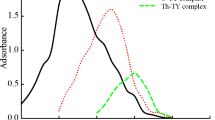Abstract
There was a significant catalytic effect of trace Gd(III) ions on the oxidative reaction of potassium persulfate with Saffron T in the acetic acid–sodium acetate buffer solution. Thus, a catalytic kinetic fluorimetry method for the determination of trace Gd(III) ions was established. The factors such as acidity, concentration of reagents, reaction time, and temperature as well as influence of coexisting ions were discussed. The optimum reaction conditions were established. The apparent rate constant and apparent activation energy of the reaction were determined. The linear range is 0.02–0.10 μg·ml−1, and the detection limit is 7.27 × 10−4 μg·ml−1. This method was used for the determination of gadolinium in the samples of lanthanum acetate with RSD of 0.9%–3.1%.







Similar content being viewed by others
References
Narendra MR, Huang LS, Lin KC, Suresh KA. Uncertainty propagation through correction methodology for the determination of rare earth elements by quadrupole based inductively coupled plasma mass spectrometry. Anal Chim Acta. 2005;530(1):91.
Li YH, Lu HY, Zhang YM, Ma J, Song GY. Synthesis and luminescence properties of nanocrystalline Gd3Ga5O12:Eu3+ by a homogeneous precipitation method. Rare Met. 2012;31(6):599.
Saussereau E, Lacroix C, Cattaneo A, Mahieu L, Goulle JP. Hair and fingernail gadolinium ICP-MS contents in an overdose case associated with nephrogenic systemic fibrosis. Forensic Sci Int. 2008;176(1):54.
Isnard H, Brennetot R, Caussignac C, Caussignac N, Chartier F. Investigations for determination of Gd and Sm isotopic compositions in spent nuclear fuels samples by MC ICPMS. Int J Mass Spectrom. 2005;246(1–3):66.
Zhang BR, Wang L, Ma SF, Wen HL, Gong AH. Interference correction in determination of Cu, Zn, Eu, Gd, Tb in geological samples by inductively coupled plasma-mass spectrometry. Rock Miner Anal. 2012;31(2):253.
Normann PT, Preben J, Martinsen I, Thomsen HS. Quantification of gadodiamide as Gd in serum, peritoneal dialysate and faeces by inductively coupled plasma atomic emission spectroscopy and comparative analysis by high-performance liquid chromatography. J Pharm Biomed Anal. 2000;22(6):939.
Wang DJ, Xu T, Li M, Guo WL. Determination of Sm, Co, Cu, Fe, Zr, and Gd in Sm Co alloy by ICP-AES. Chin Rare Earths. 2012;33(5):76.
Ma Y, Fang W, Wan YJ, Li KZ, Luo YJ, Liu W. Determination of gadolinium and beryllium in gold alloys by ICP-AES. Chin J Spectrosc Lab. 2008;25(5):947.
Ishikawa N, Tanaka N, Kaizu Y. ESR study of sublevel structure of anionic bis(phthalocyaninato)gadolinium(III). Inorg Chim Acta. 2004;357(7):2181.
Grafe JL, McNeill FE, Byun SH, Chettle DR, Noseworthy MD. A benchmarked MCNP model of the in vivo detection of gadolinium by prompt gamma neutron activation analysis. Nucl Instrum Methods Phys Res B. 2010;268(15):2451.
Whitney AH, James FR, Mariah B, Tracy P. Gadolinium deposition in nephrogenic systemic fibrosis: an examination of tissue using synchrotron X-ray fluorescence spectroscopy. J Am Acad Dermatol. 2010;62(1):38.
Strasser A, Vogler A. Phosphorescence of gadolinium(III) chelates under ambient conditions. Inorg Chim Acta. 2004;357(8):2345.
Li L, Yang JH, Wu X, Sun CX, Liu Y, Liu SF, Su BY. The fluorescence enhancement effect of Tb–Gd–adenosine triphosphate–phen system and its analytical application. Talanta. 2005;65(1):201.
Liu YL, Ai KL, Yuan QH, Lu LH. Fluorescence-enhanced gadolinium-doped zinc oxide quantum dots for magnetic resonance and fluorescence imaging. Biomaterials. 2011;32(4):1185.
Liu CY, Huang BH, Cheng XL. Fluorometric determination of cerium, gadolinium and terbium in rare earth oxides. Phys Test Chem Anal B Chem Anal. 1999;35(8):348.
Acknowledgments
This study was financially supported by the Natural Science Foundation of Shandong Province (No. Y2008B26).
Author information
Authors and Affiliations
Corresponding author
Rights and permissions
About this article
Cite this article
Chen, JP., Liu, YY. & Gao, YJ. Determination of trace gadolinium by catalytic kinetic fluorimetry. Rare Met. 34, 595–599 (2015). https://doi.org/10.1007/s12598-013-0085-2
Received:
Revised:
Accepted:
Published:
Issue Date:
DOI: https://doi.org/10.1007/s12598-013-0085-2



